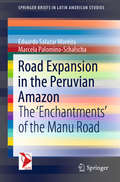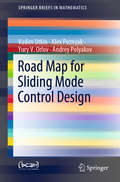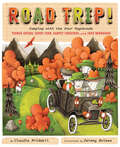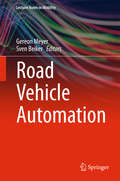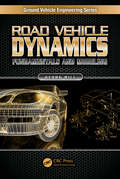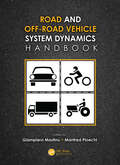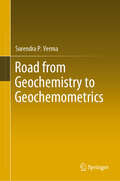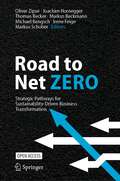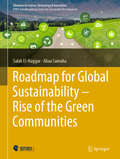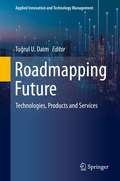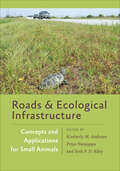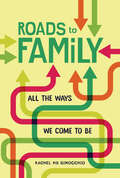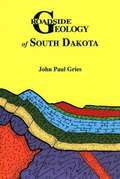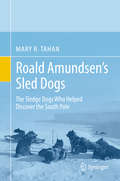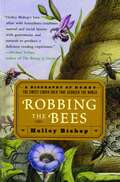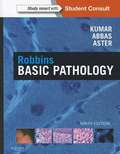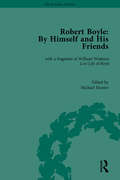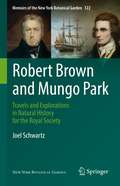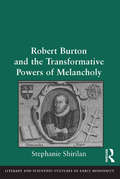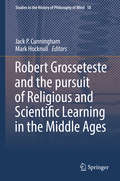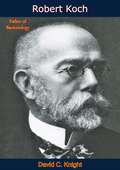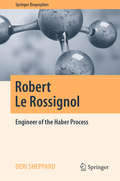- Table View
- List View
Road Expansion in the Peruvian Amazon: The 'Enchantments' of the Manu Road (SpringerBriefs in Latin American Studies)
by Marcela Palomino-Schalscha Eduardo Salazar MoreiraThis book provides in-depth insights into the construction of the first road to reach riparian communities and the main access point to a national park in the Amazonian rain forest. It is based on an ethnographic investigation in Peru’s Manu Province in the Amazon, which explored diverse local attitudes towards the construction of a road in the overlapping buffer zone of two protected areas: the Manu National Park and the Amarakaeri Communal Reserve. The book reveals the applicability of Harvey and Knox’s concept of ‘enchantments of infrastructure’ in the case of first roads, but also makes accessible wider debates in political ecology such as territoriality and frontier development. The promise of first roads sparks feelings of aspiration and anticipation of the advent of development through speedy travel, economic connectivity and political integration. Yet these developments seldom take shape as expected. The author explores the perspectives, social dynamics and political maneuvers that influence first road building processes in the Amazon, which have applicability to experiences and strategies of road development elsewhere.
Road Map for Sliding Mode Control Design (SpringerBriefs in Mathematics)
by Yury V. Orlov Andrey Polyakov Vadim Utkin Alex PoznyakThis book is devoted to control of finite and infinite dimensional processes with continuous-time and discrete time control, focusing on suppression problems and new methods of adaptation applicable for systems with sliding motions only. Special mathematical methods are needed for all the listed control tasks. These methods are addressed in the initial chapters, with coverage of the definition of the multidimensional sliding modes, the derivation of the differential equations of those motions, and the existence conditions. Subsequent chapters discusses various areas of further research. The book reflects the consensus view of the authors regarding the current status of SMC theory. It is addressed to a broad spectrum of engineers and theoreticians working in diverse areas of control theory and applications. It is well suited for use in graduate and postgraduate courses in such university programs as Electrical Engineering, Control of Nonlinear Systems, and Mechanical Engineering.
Road Trip!: Camping with the Four Vagabonds: Thomas Edison, Henry Ford, Harvey Firestone, and John Burroughs
by Claudia FriddellJoin Thomas Edison, Henry Ford, Harvey Firestone, and John Burroughs on their pioneering camping trips during the early 1900s in this energetic and entertaining nonfiction picture-book adventure.After years of inventing things that other people needed, Thomas Edison and Henry Ford realized there was something they needed—a vacation! So, the famous inventors packed up Ford's Model T and invited their good friends Harvey Firestone and John Burroughs to join them as "the Four Vagabonds" hit America's back roads to enjoy the country's natural beauty, fireside chats, and frolicking fun with friends—all while inspiring future generations to invent camping adventures of their own.&“Buckle yourself in as Claudia Friddell and Jeremy Holmes take you on a fun, creative, and certainly unique road trip with America&’s most famous vagabonds—Thomas Edison, Henry Ford, Harvey Firestone, and John Burroughs. The colorful and spirited illustrations, the stories of the Vagabond&’s bivouacking travels and campsite escapades, and the well-researched bibliography makes Road Trip! a great addition to any child&’s library!&” —Matt Andres, curatorial registrar, Edison and Ford Winter Estates
Road Vehicle Automation (Lecture Notes In Mobility Ser.)
by Gereon Meyer Sven BeikerThis contributed volume covers all relevant aspects of road vehicle automation including societal impacts, legal matters, and technology innovation from the perspectives of a multitude of public and private actors. It is based on an expert workshop organized by the Transportation Research Board at Stanford University in July 2013. The target audience primarily comprises academic researchers, but the book may also be of interest to practitioners and professionals. Higher levels of road vehicle automation are considered beneficial for road safety, energy efficiency, productivity, convenience and social inclusion. The necessary key technologies in the fields of object-recognition systems, data processing and infrastructure communication have been consistently developed over the recent years and are mostly available on the market today. However, there is still a need for substantial research and development, e.g. with interactive maps, data processing, functional safety and the fusion of different data sources. Driven by stakeholders in the IT industry, intensive efforts to accelerate the introduction of road vehicle automation are currently underway.
Road Vehicle Dynamics: Fundamentals and Modeling (Ground Vehicle Engineering)
by Georg RillIn striving for optimal comfort and safety conditions in road vehicles, today's electronically controlled components provide a range of new options. These are developed and tested using computer simulations in software in the loop or hardware in the loop environments-an advancement that requires the modern automotive engineer to be able to build ba
Road and Off-Road Vehicle System Dynamics Handbook
by Manfred Ploechl Giampiero MastinuFeaturing contributions from industry leaders in their respective fields, this volume presents comprehensive, authoritative coverage of all the major issues involved in road vehicle dynamic behavior. It begins with a short history of road and off-road vehicle dynamics followed by thorough, detailed state-of-the-art chapters on modeling, analysis and optimization in vehicle system dynamics, vehicle concepts and aerodynamics, pneumatic tires and contact wheel-road/off-road, modeling vehicle subsystems, vehicle dynamics and active safety, man-vehicle interaction, intelligent vehicle systems, and road accident reconstruction and passive safety.
Road from Geochemistry to Geochemometrics
by Surendra P. VermaThis book highlights major problems in the statistical analysis of compositions that have been known for over a century, as well as the corresponding solutions that have been put forward by specialists over the past 30 years. The basic assumptions of normality or multi-normality are pointed out and methods to test and achieve them are also covered. The conventional major and trace element geochemistry and modeling equations are discussed, and are followed by a more sophisticated multidimensional approach to data handling. The book’s main focus is on the use of statistical techniques to facilitate data interpretation. It also highlights the classification (or nomenclature) and tectonic discrimination aspects for both igneous and sedimentary rocks. The book concludes by discussing computer programs that are helping pave the way from geochemistry to geochemometrics. Written by a leading expert in the area of geochemistry, it offers a valuable guide for students and professionals in the area.
Road to Net Zero: Strategic Pathways for Sustainability-Driven Business Transformation
by Thomas Becker Irene Feige Joachim Hornegger Markus Beckmann Oliver Zipse Michael Bengsch Markus SchoberWith this open access book, delve into the insights of respected leaders from academia and industry as they unravel the intricacies of sustainability-driven business transformation. This meticulously curated edited volume reflects on The Road To Net Zero, underscoring the need for pioneering pathways. Embark on a collaborative learning journey and explore key issues along the road to transformation, such as crafting corporate sustainability strategies, new forms of corporate disclosure, transforming value chains, and harnessing the power of technological innovation. Packed with guiding questions and distilled findings from research, this book is a must-read for all decision-makers, strategists, engaged citizens, educators, and learners committed to driving change and shaping a more sustainable future.
Roadmap for Global Sustainability — Rise of the Green Communities: Rise Of The Green Communities (Advances in Science, Technology & Innovation)
by Salah El-Haggar Aliaa SamahaProgressive increases in consumer demands along with aggressive industrial consumption led the world to proximate resource depletion, weather changes, soil and air degradation and water quality deterioration. We now know that the paradigm of production at the expense of human condition is not sustainable. This book briefly explains how we reached this situation and offers suggestions as to what can be done to overcome it. It invites the best entrepreneurial talent and scientific and technological know-how to develop a sustainable economy around sustainable communities, services, and sectors. A major obstacle previously identified by involved parties was the ability of accommodating for the emerging economic growth without causing harm to the environment, especially with resource depletion. This book provides the solution by creating a need to bring on a new revolution that preserves the rights of next generations to live in a healthy environment This Sustainability Revolution requires the integration of economic, environmental, and social factor as well as the practical aspects of implementing sustainability through green activities, which are discussed throughout the book. In this book, a globalization is proposed that encourages creativity and innovation towards sustainability. With this global sustainability approach (real globalization) both rich and poor will benefit from the global sustainability approach. This will close the gap between rich and poor. Developing countries could reap the benefit of current technology without undergoing many of the growing pains associated with development of these technologies. Governments are able to better work together towards common goals now that there is an advantage in cooperation, an improved ability to interact and coordinate, and a global awareness of issues. The book presents a sustainability roadmap to bring together various concepts, that have been dealt with independently by previous authors, and link them to establish the fundamental practical steps. The flow path and the direction for successful implementation of a sustainability roadmap are also discussed in detail in the book. For the first time, the authors use sustainable communities to create a better quality of life for residents while minimizing the use of the resources to meet current needs and ensure adequate resources for future generations. These green communities create new industries for the local economy and improve public health, which offers more hope for their citizens. Sustainable transportation, renewable energy, recycling, clean water, and urban forests help to make a more livable community and help to control the global climate change. They involve all citizens and incorporate local values into decision-making.
Roadmapping Future: Technologies, Products and Services (Applied Innovation and Technology Management)
by Tuğrul U. DaimThis volume presents a portfolio of cases and applications on technology roadmapping (TRM) for products and services. It provides a brief overview on criteria or metrics used for evaluating the success level of TRM and then offers six case examples from sectors such as transportation, smart technologies and household electronics. A new innovation in this book is a section of detailed technology roadmap samples that technology managers can apply to emerging technologies.
Roads and Ecological Infrastructure: Concepts and Applications for Small Animals (Wildlife Management and Conservation)
by Kimberly M. Andrews, Priya Nanjappa and Seth P. D. RileyA practical guide that explains how we can design roads that are compatible with populations of small wildlife.Few of us think twice about driving on roads. Yet the very presence of roads and the act of driving on them can impact the ecological infrastructure that supports an animal's daily life. What chance does a turtle have of successfully laying its eggs when it needs to traverse a busy highway? Is it realistic to expect small mammals to breed when an interstate thoroughfare subdivides their population? These are the sorts of challenges faced by small, often slow-moving, animals, challenges that road engineers and ecologists are trying to address.For countless small species, vehicles traveling at high speeds are nothing less than missiles shooting across migration pathways. For too many animals, the danger can lead to the loss of populations, in part because they simply are not programmed to react to traffic. Salamanders faced with a two-lane road between the forest and their aquatic breeding site, for example, will typically cross that road regardless of the congestion. The result can be hundreds of flattened animals in a single night.Roads and Ecological Infrastructure is the first book to focus on reducing conflict between roads and small animals. Highlighting habitat connections and the challenges and solutions from both transportation and ecological perspectives, the volume covers various themes, including animal behavior related to roads and design approaches to mitigate the negative effects of roads on wildlife. The chapter authors—from transportation experts to university researchers—each promote a goal of realistic problem solving. Conceptual and practical, this book will influence the next decade or more of road design in ecologically sensitive areas and should prevent countless unnecessary wildlife fatalities.Published in association with The Wildlife Society.
Roads to Family: All the Ways We Come to Be
by Rachel HS GinocchioExamine—and appreciate—the many ways in which people can create a family. This informative compendium goes beyond the basics of sexual reproduction to examine the diversity of medical and societal methods people use, including in-vitro fertilization, surrogacy, adoption, and more. Through scientific research, diagrams, and interviews with families, author Rachel Ginocchio provides a thoughtful and thorough examination of the possibilities available.
Roadside Geology of South Dakota
by John P. Gries James GriesemerA layperson's geological road map describing rocks and landforms along South Dakota's highways, as well as the geology lying beneath in caves and mine shafts. Gries (geology, South Dakota School of Mines) keeps it simple but informative, traveling from the glaciated prairies, across the Missouri River, and into the rugged Badlands Wall, the Needles, and the Homestake gold mine in the the West. Stops along the way include geologic tours of the Black Hills, Mount Rushmore, Wind Cave National Park, and Jewel Cave National Monument. Includes maps and photographs. Annotation c. by Book News, Inc., Portland, Or.
Roald Amundsen’s Sled Dogs: The Sledge Dogs Who Helped Discover the South Pole
by Mary R. TahanThis book is an analytical account of how Roald Amundsen used sledge dogs to discover the South Pole in 1911, and is the first to name and identify all 116 Polar dogs who were part of the Norwegian Antarctic Expedition of 1910–1912. The book traces the dogs from their origins in Greenland to Antarctica and beyond, and presents the author’s findings regarding which of the dogs actually reached the South Pole, and which ones returned.Using crewmember diaries, reports, and written correspondence, the book explores the strategy, methodology, and personal insights of the explorer and his crew in employing canines to achieve their goal, as well as documents the controversy and internal dynamics involved in this historic discovery. It breaks ground in presenting the entire story of how the South Pole was truly discovered using animals, and how deep and profound the differences of perception were regarding the use of canines for exploration.This historic tale sheds light on Antarctic exploration history and the human-nature relationship. It gives recognition to the significant role that animals played in this important part of history.
Roar: A Dinosaur Tour
by Michael PaulDiscover the different types of dinosaurs that once roamed the Earth in this simplistic and vibrantly illustrated picture book perfect for young nonfiction readers.A long, long time ago, dinosaurs roamed the earth.Some were big, and some were little. Some were fast, and some were slow. Some lived alone, and some lived together. They are gone now, but you can still see their bones at museums all around the world.Simple text and bold, vibrant illustrations take young explorers on a tour through the time of the dinosaurs.Don't Miss More from Michael Paul in Chomp: A Shark Romp!
Robbing the Bees: A Biography of Honey--The Sweet Liquid Gold that Seduced the World
by Holley Bishop"Honey has been waiting almost ten million years for a good biography," writes Holley Bishop. Bees have been making this food on Earth for hundreds of millennia, but we humans started recording our fascination with it only in the past few thousand years -- painting bees and hives on cave and temple walls and papyrus scrolls, revering them in poetry and art, even worshipping these amazing little insects as gods. From the temples of the Nile to the hives behind the author's own house, people have had a long, rapturous love affair with the beehive and the seductive, addictive honey it produces. Combining passionate research, rich detail, and fascinating anecdote, Holley Bishop's Robbing the Bees is an in-depth, sumptuous look at the oldest, most delectable food in the world.Part biography, part history, Robbing the Bees is also a celebration, a love letter to bees and their magical produce. Honey has played significant and varied roles in civilization: it is so sweet that bacteria can't survive in it, so it was our first food preservative and all-purpose wound salve. Honey wine, or mead, was the intoxicant of choice long before beer or wine existed. Hindus believe honey leads to a long life; Mohammed looked to honey as a remedy for all illness. Virgil; Aristotle; Pythagoras; Gregor Mendel; Sylvia Plath's father, Otto; and Sir Edmund Hillary are among the famous beekeepers and connoisseurs who have figured in honey's past and shaped its present.To help navigate the worlds and cultures of honey, Holley Bishop -- beekeeper, writer, and honey aficionado -- apprentices herself to a modern guide and expert, professional beekeeper Donald Smiley, who harvests tupelo honey from hundreds of hives in the remote town of Wewahitchka, Florida. Bishop chronicles Smiley's day-to-day business as he robs his bees in the steamy Florida panhandle and provides an engaging exploration of the lively science, culture, and lore that surround each step of the beekeeping process and each stage of bees' lives.Interspersed throughout the narrative are the author's lyrical reflections on her own beekeeping experiences, the business and gastronomical world of honey, the myriad varieties of honey (as distinct as the provenance of wine), as well as illustrations, historical quotes, and recipes -- ancient, contemporary, and some of the author's own creations.
Robbins Basic Pathology
by Vinay Kumar Abul Abbas Jon AsterRobbins Basic Pathology delivers the pathology knowledge you need, the way you need it, from the name you can trust! This medical textbook’s unbeatable author team helps you efficiently master the core concepts you need to know for your courses and USMLE exams.
Robert Boyle: With a Fragment of William Wotton's 'Lost Life of Boyle' (The\pickering Masters Ser.)
by Michael HunterThe image of Robert Boyle owes much to a series of evaluations of him written shortly after his death by men who had known him well, such as John Evelyn, Gilbert Burnet and Sir Peter Pett. This book includes a selection of these previously unpublished texts.
Robert Brown and Mungo Park: Travels and Explorations in Natural History for the Royal Society (Memoirs of The New York Botanical Garden #122)
by Joel SchwartzExplorer-naturalists Robert Brown and Mungo Park played a pivotal role in the development of natural history and exploration in the late eighteenth and early nineteenth centuries. This work is a fresh examination of the lives and careers of Brown and Park and their impact on natural history and exploration. Brown and Park were part of a group of intrepid naturalists who brought back some of the flora and fauna they encountered, drawings of what they observed, and most importantly, their ideas. The educated public back home was able to gain an understanding of the diversity in nature. This eventually led to the development of new ways of regarding the natural world and the eventual development of a coherent theory of organic evolution. This book considers these naturalists, Brown, Park, and their contemporaries, from the perspective of the Scottish Enlightenment. Brown’s investigations in natural history created a fertile environment for breakthroughs in taxonomy, cytology, and eventually evolution. Brown’s pioneering work in plant taxonomy allowed biologists to look at the animal and plant kingdoms differently. Park’s adventures stimulated significant discoveries in exploration. Brown and Park’s adventures formed a bridge to such journeys as Charles Darwin’s voyage on H.M.S. Beagle, which led to a revolution in biology and full explication of the theory of evolution.
Robert Burton and the Transformative Powers of Melancholy (Literary and Scientific Cultures of Early Modernity)
by Stephanie ShirilanFew English books are as widely known, underread, and underappreciated as Robert Burton’s The Anatomy of Melancholy. Stephanie Shirilan laments that modern scholars often treat the Anatomy as an unmediated repository of early modern views on melancholy, overlooking the fact that Burton is writing a cento - an ancient form of satire that quotes and misquotes authoritative texts in often subversive ways - and that his express intent in so doing is to offer his readers literary therapy for melancholy. This book explores the ways in which the Anatomy dispenses both direct physic and more systemic medicine by encouraging readers to think of melancholy as a privileged mental and spiritual acuity that requires cultivation and management rather than cure. Refuting the prevailing historiography of anxious early modern embodiment that cites Burton as a key witness, Shirilan submits that the Anatomy rejects contemporary Neostoic and Puritan approaches to melancholy. She reads Burton’s erraticism, opacity, and theatricality as modes of resistance against demands for constancy, transparency, and plainness in the popular literature of spiritual and moral hygiene of his day. She shows how Burton draws on rhetorical, theological, and philosophical traditions that privilege the transformative powers of the imagination in order to celebrate melancholic impressionability for its capacity to inspire and engender empathy, charity, and faith.
Robert Fulton, Boy Craftsman
by Marguerite HenryRobert Fulton-Boy Craftsman is the biography for children that talks about young Robert Fulton - the helpful, responsible boy who grew up to become a portrait and landscape artist, an engineer, and an inventor who constructed the first successful steamboat.
Robert Grosseteste and the pursuit of Religious and Scientific Learning in the Middle Ages
by Jack P. Cunningham Mark HocknullThis book explores a wide range of topics relating to scientific and religious learning in the work of Bishop Robert Grosseteste (c. 1168-1253) and does so from various perspectives, including those of a twenty-first century scientists, historians, and philosophers as well as several medievalists. In particular, it aims to contribute to our understanding of where to place Grosseteste in the history of science (against the background of the famous claim by A. C. Crombie that Grosseteste introduced what we now might call "experimental science") and to demonstrate that the polymathic world of the medieval scholar, who recognized no dichotomy in the pursuit of scientific and philosophical/theological understanding, has much to teach those of us in the modern world who wrestle with the vexed question of the relationship between science and religion. The book comprises an edited selection of the best papers presented at the 3rd International Robert Grosseteste Conference (2014) on the theme of scientific and religious learning, especially in the work of Grosseteste.
Robert Grosseteste and the pursuit of Religious and Scientific Learning in the Middle Ages (Studies in the History of Philosophy of Mind #18)
by Jack P. Cunningham Mark HocknullThis book explores a wide range of topics relating to scientific and religious learning in the work of Bishop Robert Grosseteste (c. 1168–1253) and does so from various perspectives, including those of a twenty-first century scientists, historians, and philosophers as well as several medievalists. In particular, it aims to contribute to our understanding of where to place Grosseteste in the history of science (against the background of the famous claim by A.C. Crombie that Grosseteste introduced what we now might call “experimental science”) and to demonstrate that the polymathic world of the medieval scholar, who recognized no dichotomy in the pursuit of scientific and philosophical/theological understanding, has much to teach those of us in the modern world who wrestle with the vexed question of the relationship between science and religion. The book comprises an edited selection of the best papers presented at the 3rd International Robert Grosseteste Conference (2014) on the theme of scientific and religious learning, especially in the work of Grosseteste.
Robert Koch: Father of Bacteriology
by David C. KnightNO OTHER scientist has so aptly earned the title of “father” of his branch of science than Robert Koch. While Pasteur is regarded as the greatest applied bacteriologist, it was Koch who first perfected the pure techniques of cultivating and studying bacteria.When Koch succeeded in isolating the dreaded anthrax bacillus, he became the first to prove that a specific bacterium was the cause of a specific disease. He also developed four famous rules—still in use today—for relating one kind of bacteria to one kind of disease. Later, he succeeded in growing pure cultures of bacteria, an essential technique in modern bacteriology.In 1882, Koch astounded the scientific world by first isolating the tubercle bacillus—the cause of tuberculosis. Later he discovered tuberculin, a substance used in diagnosing tuberculosis today. A tireless worker, Koch went on to save thousands of lives, both human and animal, through his investigation of Asiatic cholera, sleeping sickness, malaria, Texas fever, rinderpest, and Rhodesian red water fever.
Robert Le Rossignol: Engineer of the Haber Process (Springer Biographies)
by Deri SheppardA principal aim of this first biography of Robert Le Rossignol, engineer of the Haber process, is to bring new evidence to the attention of the scientific community allowing a re-assessment of the origins of the 'Haber' process. However, the scope of the book is much wider and goes beyond the discovery of 'fixation' to account for a life distinct from Haber, one full of remarkable science, cruel circumstance, personal tragedy and amazing benevolence, the latter made possible by Haber’s generous financial arrangement with Le Rossignol regarding his royalties from the BASF.
